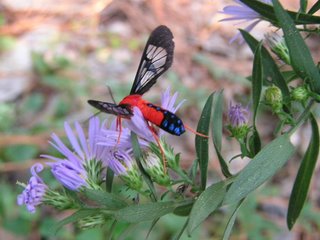
Isn't that a cool name? It's a pretty cool moth, too. Not easy to forget, once you've seen one.
I first found one dead on my doorstep, believe it or not, about a week ago. With my eyeglasses needing an update and my fantastic old loop magnifying glass playing a permanent game of hide-and-go-seek with me, I wasn't quite sure what type of insect it was. So I picked it up and saved it on a plate in the refrigerator, hoping to be able to identify it.
Two days ago in the late afternoon, I noticed several dozen of these unknown insects feeding on the asters in the back yard. I'd been enjoying all of the other "bugs" at the asters, but this was the first time I'd seen these creatures in the mix. They were even more dazzling alive than dead. (To give you an idea of scale, their bodies range from 1/2 - 3/4" in length.)
By watching closely, I was able to figure out that these guys were feeding with a proboscis, nailing their identity as a moth. I checked my guides, but the only information I could find out was that clearwing moths, as a family, are borers and can actually cause quite a bit of damage. Peach borers and dogwood borers, for example, are in this family. That caused my heart to sink, and I had visions of these beautiful insects creating untold havoc in their larval stage.
Luckily, a quick Google search set me straight. This is a scarlet bodied wasp moth, and it is indeed in the clearwing moth family. Its host plant, however, is the climbing hempvine - not what you would call an important commercial plant! This moth is considered to be a tropical species, which is why I wasn't able to find it in the guides that I had.
So I can enjoy these little beauties with a clear conscience. I've noticed that I primarily see them in the late afternoon, rather than throughout the day, despite the fact that they are supposed to be diurnal. Who knows what else I can discover about their habits as I watch them making themselves at home in my garden?
No comments:
Post a Comment